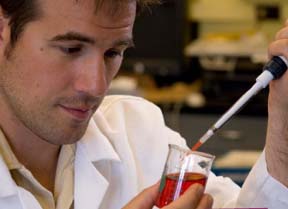Aaron Strickland is a chemist studying Nanotechnology. At the time of this interview, Aaron Strickland was a postdoctoral research associate and National Science Foundation Discovery Corps Fellow at Cornell University. He is now Vice President of Research and Development at iFyber, a small company in Ithaca, NY.
Where did you grow up and what was your childhood like?
I was born and raised in Wyoming. I’d say I was a pretty “normal” kid with interests that ranged from sports to hunting and fishing. My father was an ecologist for the Wyoming Game and Fish Department and my mother was an elementary school teacher.I have one older brother. I attended public school and devoted a lot of time to competitive sports and probably not enough time to my schoolwork. I did well in school but I would not say I excelled until I got into college.
When you were a kid what interested you about science? What was the first experiment you did?
I was probably most interested in the natural sciences as a kid, which is likely a result of growing up in Wyoming. Wyoming has a lot of amazing wildlife and geological formations, which inspired me to learn about these things that were literally at my doorstep. The first “real” experiment I did as a kid was in my high school science class. I exposed growing plants to acidic water to simulate acid rain. At the time—and still today—I am interested in how people affect the natural world around them. It was very fulfilling for me to systematically design an experiment to study how plants respond to contaminants such as acid rain. I was actually awarded a scholarship to college for that work, and this competitive aspect of science was also appealing to me.
Did you always think you were going to be in research?
Definitely not. I had the usual dreams of becoming an astronaut or doctor as many other kids. I started my college life out wanting to pursue medical school, which quickly turned to engineering and then I settled on chemistry. Near the end of my college career I was able to work on an independent research project and it was then that I knew I liked science research. With some direction by my professors I was given freedom to pursue a research idea that I came up with. Mistakes and hardships occurred along the way; however, the work involved creative thought, intense learning and problem solving, which were all very energizing for me.
Where do you come up with your ideas?
Though I don’t think I have the type of experience and understanding to develop truly “groundbreaking” ideas, my interests are very broad and I have a decent ability to connect the dots between seemingly unrelated scientific concepts or problems. For example, I read scientific literature and attend scientific discussions outside my immediate field of chemistry, and try to apply my skills as a chemist to solving problems using a different and hopefully better approach. I may read a scientific paper on how glucose sensors work for treatment of diabetes and draw from my scientific background to answer the question, “How would I build a glucose sensor?” Most of my ideas start with me brainstorming in a very general way, and then refining an idea by filling the gaps either through discussions with other scientists and/or learning about what is known.
Do you see molecules?
I’m a little embarrassed to say yes, I do “see” molecules. However, I see them as drawings on paper, which is how chemists—especially organic chemists like myself—visualize the makeup or interactions of the chemicals we use. In many ways, visualizing these molecules actually allows me to progress an idea I may have without actually doing any physical work. Tough job, I know. One area that you have worked in is self-assembly. What’s that all about? Self-assembly is exactly what it sounds like: it makes stuff out of material without any help. Though most often things tend to get messy, under appropriate conditions, disordered objects like groups of molecules will come together (self-assemble) into organized structures or patterns. Like the process of forming ice from water. Currently, I am studying a self-assembly process that exists in nature on the surface of many bacteria. If one looks at these surfaces with a really powerful microscope there is very amazing structure and order to the surface, which is made of protein we call S-layer protein. S-layers contain patterns of peaks and valleys and pores that are arranged in perfect patterns, such as tiny hexagons, that repeat over the entire surface of the bacteria. These hexagons are spaced at only 20 nanometers apart and form a very stable layer that helps protect the bacteria.We would like to repeat this S-layer assembly in the laboratory to study this natural process, and to make use of this precise arrangement of matter over relatively large areas. In the future, this process could be used to build unique catalysts, optical devices, sensors, and other things that cannot be achieved using current technologies. For example, if we can build self-assembled structures with conductive nanoparticles, we could jump-start advances in longer-lasting batteries or build smaller computing chips.
Does everyone who finds out you are from Wyoming think you are a cowboy?
Mostly, and I have to explain to them that despite having horses, I in fact drove a car or rode a bus to school and NOT a horse or a horse-drawn wagon.
Listen to Aaron’s story in Chronicles of a Science Experiment, produced by EarthSky at www.earthsky.org.

